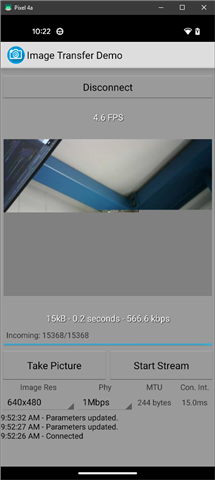Hello,
I am trying to the build the following demo from github on Keil:
https://github.com/NordicPlayground/nrf52-ble-image-transfer-demo
I am using Keil uVision V5 MDK-Lite with default compiler V6 along with nRF5SDK160098a08e2 and s132nrf52701 softdevice
I managed to get the softdevice, Nordic Packages, etc. setup properly (I think!)
I flashed (loaded) the s132_nrf52_7.0.1_softdevice.hex to the nRF52 DK nRF52832 eval boards
I get the following build errors:
Build started: Project: image_transfer_demo_pca10040_s132
*** Using Compiler 'V6.19', folder: 'C:\Keil_v5\ARM\ARMCLANG\Bin'
*** Warning: You are compiling one or more files of source type C++ and have selected 'use MicroLIB'. MicroLIB does not support C++!
Build target 'nrf52832_xxaa'
ArmClang: error: no such file or directory: '../../../../../../components/libraries/bsp/bsp.c'
ArmClang: error: no input files
compiling bsp.c...
ArmClang: error: no such file or directory: '../../../../../../components/libraries/bsp/bsp_btn_ble.c'
ArmClang: error: no input files
compiling bsp_btn_ble.c...
RTE/Device/nRF52832_xxAA/system_nrf52.c(30): error: 'nrf52_erratas.h' file not found
#include "nrf52_erratas.h"
^~~~~~~~~~~~~~~~~
1 error generated.
compiling system_nrf52.c...
C:/Nordic/sdk/nRF5SDK160098a08e2/components/libraries/util/app_error_handler_keil.c(45): error: expected '(' after 'asm'
__ASM void app_error_handler(ret_code_t error_code, uint32_t line_num, const uint8_t * p_file_name)
^
C:/Nordic/sdk/nRF5SDK160098a08e2/components/libraries/util/app_error_handler_keil.c(45): error: expected ';' after top-level asm block
__ASM void app_error_handler(ret_code_t error_code, uint32_t line_num, const uint8_t * p_file_name)
^
;
C:/Nordic/sdk/nRF5SDK160098a08e2/components/libraries/util/app_error_handler_keil.c(47): error: use of undeclared identifier 'PRESERVE8'
PRESERVE8 {TRUE}
^
3 errors generated.
compiling app_error_handler_keil.c...
".\_build\nrf52832_xxaa.axf" - 8 Error(s), 0 Warning(s).
Target not created.
Build Time Elapsed: 00:00:01
For the
ArmClang: error: no such file or directory: '../../../../../../components/libraries/bsp/bsp.c'
ArmClang: error: no input files
compiling bsp.c...
ArmClang: error: no such file or directory: '../../../../../../components/libraries/bsp/bsp_btn_ble.c'
ArmClang: error: no input files
errors: I did make sure the both C/C++ and ASM Include Paths point to the SDK I downloaded but I still get these errors.
Please advise.
Thanks,
Adnan





